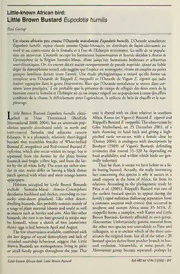
Little-known African bird: Little Brown Bustard Eupodotis humilis PDF
Preview Little-known African bird: Little Brown Bustard Eupodotis humilis
Little-known African bird: Little Brown Bustard Eupodotis humilis PaulGoriup Un oiseau africain peu connu: l’Outarde somalienne Eupodotis humilis. L’Outarde somalienne Eupodotis humilis, espece classee comme Quasi-Menacee, est distribute de fa^on clairsemee au nord et au centre-ouest de la Somalie et a Test de l’Ethiopie avoisinante. La taille de sa popula- tion est inconnue. L’outarde occupe les formations buissonnantes et fourres decidus aAcacia et Commiphora de la Region Somalie-Masai, allant jusqu’aux formations herbeuses et arbustives semi-desertiques. On n’a encore decrit aucun comportement de parade nuptiale: ajoute au faible degrededimorphismesexuel, celasuggerequeTespeceestmonogame,vivantencouples oupetits groupes familiaux durant toute l’annee. Une etude phylogenetique a trouve quelle forme un complexe avec l’Outarde de Riippell E. rueppellii et TOutarde de Vigors E, vigorsii qui jadis etaient regoupees dans le genre Heterotetrax. Bien que TOutarde somalienne se trouve dans cer- taines ‘aires protegees,’ il est probable que la presence de camps de refugies des deux cotes de la frontiereentrelaSomalieetTEthiopieaiteuun impactnegatifsursapopulationacausedeseffets combines de la chasse, le defrichement pour Tagriculture, la collecte de bois de chauffe et le sur- paturage. Little Brown Bustard Eupodotis humilis, classi- trait is shared with its close relatives in southern fied as Near Threatened (BirdLife Africa, Karoo (or Vigors’s) Bustard E. vigorsii and International 2000, 2004), has an uncertain pop- Rlippell’s BustardE. rueppellii. Theobservationby ulation sparsely distributed solely in north and Giles Mulholland, on 25 December 2003, of a west-central Somalia and adjacent eastern male throwing its head back and giving a high- Ethiopia. It is a plumpish, relatively short-legged pitched rattle we-we-we, with a female close by bustard that resembles females of White-bellied (Demey 2004), is analogous with descriptions by Bustard E. senegalensisand Red-crested Bustard E. Boobyer (1989) of Vigors’s Bustards defending ruficrista, which also occurwithin its range, but is territories that extend 55-320 ha depending on separated from the former by the plain brown food availability, and within which birds are gen- foreneck and bright yellow legs, and from the lat- erally sedentary. ter bythe all-white bellyThe sexes are rathersim- Thus far then, itseemswe have before us alit- ilar in size; males differ in having a black throat tle boring bustard. Actually, the really interesting patch spottedwith white and more orange-brown fact concerning this species is why it occurs in a upperparts. small outpost in the horn ofAfrica, far from its Habitats occupied by Little Brown Bustards relatives. According to the phylogenetic study by include Somalia-Masai Acacia-Commiphora Pitra et al. (2001), Ruppell’s Bustard was one of deciduous bushlandand thicket, extendingto tus- the earliest bustard species to appear during the socky semi-desert grassland. Like other desert- family’s rapidradiation (followingseparationfrom dwellingbustards, dietprobablyconsists mainlyof a common ancestor with cranes) that occurred in arangeofplantmaterial (shoots andseeds) aswell southern and eastern Africa some 85 MYA. E. as insects such as beetles and ants. Also like other rueppellii forms a complex, with Karoo and Little bustards, the nest is on bare ground (ascrape may Brown Bustards, formerly afforded its own genus, be formed), where a clutch of two (sometimes Heterotetrax. Unfortunately, genetic material from three) eggs is laid betweenApril andAugust. the other two species was unavailable to Pitra and Thefewobservationsavailable, combinedwith colleagues, so it is unclearwhich ofthe three con- the low degree ofsexual dimorphism and lack of stitutes the original form, but all ofthe other c.20 recorded courtship behaviour, suggest that Little bustardspeciesderivefrom anotherbranchinbus- Brown Bustards are monogamous, living in pairs tard evolution. Meanwhile, at some point, the or small family groups throughout the year. This Heterotetrax group became separated, perhaps by Little-knownAfrican bird:LittleBrownBustard BullABCVol13No2(2006)-217 Figures 1-2. MaleLittle Brown BustardEupodotishumilis, north-westSomalia,June2005 (JohnMiskell) OutardesomalienneEupodotishumilis, male, Somaliedunord-ouest,juin2005 (John Miskell) climate-relatedhabitatchange, andtheancestorof References humilis was pushed ever further north-east; or a BirdLife International. 2000. Threatened Birds ofthe & contiguous population within a corridor from World. Barcelona: Lynx Edicions Cambridge, south-west to north-eastAfrica became fragment- UK: BirdLife International. ed, eventually leaving a pocket population in the BirdLife International. 2004. Threatened Birds ofthe horn. Either way, if such trends are still in World2004. CD-ROM. Cambridge, UK: BirdLife progress, then clearly the Little Brown Bustard is International. veryvulnerable, trapped in its corner ofAfrica. Boobyer, M. G. 1989. The Eco-ethology ofthe Karoo Little Brown Bustards occur in a number of Korhaan. MSc. thesis. UniversityofCapeTown. ‘protected areas’ in Somalia and Ethiopia. Demey, R. 2004. Recent reports. Bull. ABC 11: 168-182. However, the continuing presence of refugee & camps on both sides ofthe Ethiopia-Somalia bor- Pitra, C., Lieckfeldt, D., Frahnert, S. Fickel, J. 2002. Phylogeneticrelationshipsandancestralareasofthe der is likely to have impacted its population bustards (Gruiformes: Otididae), inferred from through the combined effects ofhunting, cultiva- mitochondrial DNAand nuclearintron sequences. tion, firewood collection and overgrazing. The & Mol. Phyl. Evol. 23: 63-74. bird deserves more conservation attention than it receives at present. FieldfareInternationalEcologicalDevelopmentpic, 36 Kingfisher Court, Hambridge Road, Newbury RG14 5SJ, UK. E-mail:[email protected] Received23 May2006 218-BullABClto!13No2(2006) Little-knownAfrican bird:LittleBrownBustard
